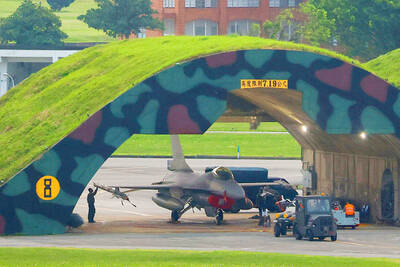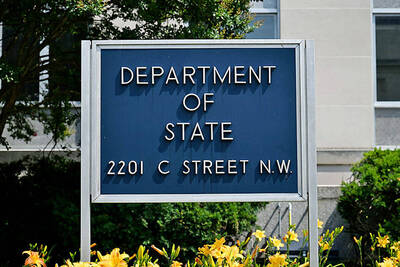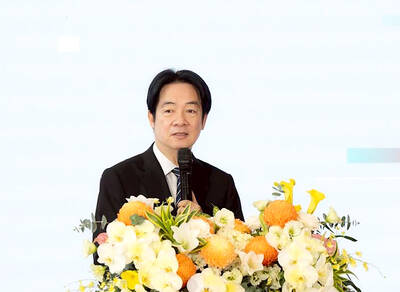A US congressional report released this week makes it clear that, without the acquisition of new aircraft, the Taiwanese air force risks being a shadow of itself by 2020 and incapable of meeting the challenge it faces in the Taiwan Strait.
The annual report by the Congressional Research Service, entitled Taiwan: Major US Arms Sales Since 1990 — which Defense News has called “required reading inside Taiwan defense circles and among US defense officials working with the island’s military” — provides a detailed analysis of US arms sales to Taiwan over more than two decades.
The section on F-16 jet sales provides the greatest shock. By 2020, it says, the number of fighter aircraft in the air force would drop by 70 percent without the acquisition of new F-16s as it retires near-obsolete F-5s and some ageing Mirage 2000s, whose spare parts are reportedly extremely costly.
Even if Taiwan were to acquire the 66 F-16C/Ds it has been requesting since 2006, the total number of aircraft would still have dropped by 50 percent by that time, the report says.
In numerous requests to the US over the years, Taiwan had made it clear that it understands the severity of the shortage it faces within the next decade and it has argued that it is seeking both upgrades for its 145 F-16A/Bs sold in 1992 and new aircraft.
In a letter of request submitted in November 2009, Taiwan wrote that the upgrade program would by necessity be “in parallel to, and not a substitute for, new F-16C/D” aircraft.
On a visit to the US in September last year, Vice Minister of National Defense Andrew Yang (楊念祖) called the F-16C/Ds and diesel-electric submarines — another program that has been stalled for several years — the most urgent systems for Taiwan to acquire, not the F-16A/B upgrades.
A notification to Congress in September last year included a US$5.2 billion upgrade package for the F-16A/Bs, but not the new F-16C/Ds. The Ministry of National Defense says the retrofits, which would be budgeted over a period of 12 years, would bring the F-16A/Bs’ capabilities to 80 percent of those of the F-16C/D, with some capabilities even surpassing the F-16C/D.
However, the package does not include new engines, meaning that their operational range would remain more limited than that of F-16C/Ds. The program also does not include airframe work, leaving unaddressed the problem of ageing aircraft that have now been in service for two decades.
According to Lockheed Martin, a retrofit would not start until 2017, after five years of preparatory work. Once it begins, it would take one squadron, or about 24 F-16A/Bs, out of service at a time over a period of five years.
Furthermore, the program would take three years longer than a program to sell the same number of 145 new F-16C/D fighters, which it says would take seven years.
During that same period, a number of Indigenous Defense Fighters (IDF) will also be out of service for mid-life upgrades, further compounding the quantitative crisis.
More recent events, which are not covered in the CRS report, seem to indicate that Taiwan is having second thoughts about running the two programs in parallel. Earlier this month, legislators and senior military officials said that the F-16A/B upgrades were more expensive than expected and that Taiwan might not have the financial resources to do both. Some also argued that rather than purchase the new F-16C/Ds, Taiwan should instead bid for Lockheed Martin’s F-35B, a problem-plagued aircraft that is still under development.
Such signaling has given rise to speculation in defense circles that Taiwan might want out of the F-16C/D project, at a time when the White House may finally be willing to make the aircraft available. A defense industry source told the Taipei Times yesterday that Taiwan’s National Security Council has been informed of the urgency of submitting a new letter of request for the F-16C/Ds to push the issue, but that such recommendations had “disappeared into a black hole.”
A strong indicator of a possible shift occurred on Thursday when President Ma Ying-jeou (馬英九) met former Florida governor Jeb Bush, who arrived the same day on a three-day visit.
Although some were expecting that Ma would restate Taiwan’s interest in acquiring the F-16C/Ds, the president only mentioned the upgrades, telling Bush he hoped the program would provide the F-16A/Bs with capabilities “close to” those of the F-16C/Ds.

MISINFORMATION: The generated content tends to adopt China’s official stance, such as ‘Taiwan is currently governed by the Chinese central government,’ the NSB said Five China-developed artificial intelligence (AI) language models exhibit cybersecurity risks and content biases, an inspection conducted by the National Security Bureau (NSB) showed. The five AI tools are: DeepSeek, Doubao (豆包), Yiyan (文心一言), Tongyi (通義千問) and Yuanbao (騰訊元寶), the bureau said, advising people to remain vigilant to protect personal data privacy and corporate business secrets. The NSB said it, in accordance with the National Intelligence Services Act (國家情報工作法), has reviewed international cybersecurity reports and intelligence, and coordinated with the Ministry of Justice Investigation Bureau and the National Police Agency’s Criminal Investigation Bureau to conduct an inspection of China-made AI language

BOOST IN CONFIDENCE: The sale sends a clear message of support for Taiwan and dispels rumors that US President Donald Trump ‘sold out’ the nation, an expert said The US government on Thursday announced a possible sale to Taiwan of fighter jet parts, which was estimated to cost about US$330 million, in a move that an expert said “sends a clear message of support for Taiwan” amid fears that Washington might be wavering in its attitude toward Taipei. It was the first announcement of an arms sale to Taiwan since US President Donald Trump returned to the White House earlier this year. The proposed package includes non-standard components, spare and repair parts, consumables and accessories, as well repair and return support for the F-16, C-130 and Indigenous Defense Fighter aircraft,

CHECKING BOUNDARIES: China wants to disrupt solidarity among democracies and test their red lines, but it is instead pushing nations to become more united, an expert said The US Department of State on Friday expressed deep concern over a Chinese public security agency’s investigation into Legislator Puma Shen (沈伯洋) for “secession.” “China’s actions threaten free speech and erode norms that have underpinned the cross-strait ‘status quo’ for decades,” a US Department of State spokesperson said. The Chongqing Municipal Public Security Bureau late last month listed Shen as “wanted” and launched an investigation into alleged “secession-related” criminal activities, including his founding of the Kuma Academy, a civil defense organization that prepares people for an invasion by China. The spokesperson said that the US was “deeply concerned” about the bureau investigating Shen

‘TROUBLEMAKER’: Most countries believe that it is China — rather than Taiwan — that is undermining regional peace and stability with its coercive tactics, the president said China should restrain itself and refrain from being a troublemaker that sabotages peace and stability in the Indo-Pacific region, President William Lai (賴清德) said yesterday. Lai made the remarks after China Coast Guard vessels sailed into disputed waters off the Senkaku Islands — known as the Diaoyutai Islands (釣魚台) in Taiwan — following a remark Japanese Prime Minister Sanae Takaichi made regarding Taiwan. Takaichi during a parliamentary session on Nov. 7 said that a “Taiwan contingency” involving a Chinese naval blockade could qualify as a “survival-threatening situation” for Japan, and trigger Tokyo’s deployment of its military for defense. Asked about the escalating tensions